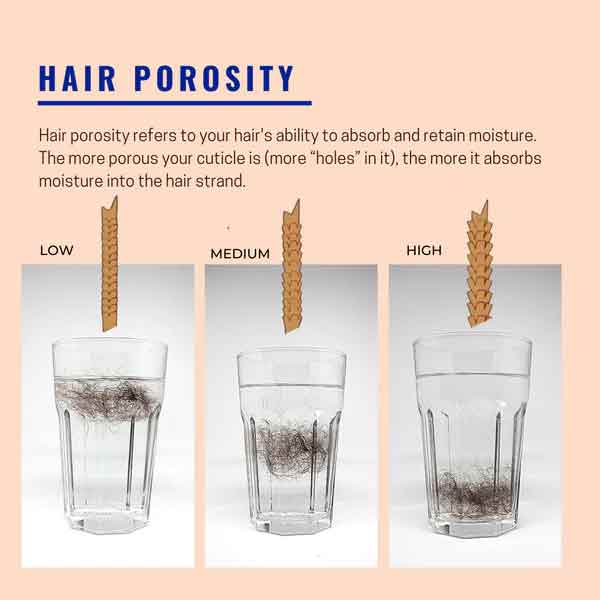Understanding your hair structure can seem like a daunting task. However, once you’ve cracked the code, you’ll be able to choose the right products, avoid damaging habits, and maximize the health of your hair. In this guide, we’ll explain how to determine your hair texture, density, thickness, porosity, and scalp condition, and provide tips on how to take care of each. Remember, everyone’s hair is unique, so it’s important to embrace your natural texture and cater to your individual needs.
A Quick Introduction to Hair Textures
Hair texture refers to the natural shape or pattern of your strands. If you’re looking to discover your natural hair texture, the Andre Walker system, created by Oprah Winfrey’s stylist, is the most widely known classification system.
More from Glowing Gorgeous: Find out here the Best Silicone-Free Moisturizers And Why Do You Care
Decoding Hair Textures
The system categorizes hair textures into four types: Type 1 is straight, Type 2 is wavy, Type 3 is curly, and Type 4 is coily. Each type is then divided into three subcategories, A, B, and C, to further specify the tightness of the wave, curl, or coil.
For instance, type 1A represents straight hair that is fine and thin, while 4C hair is coily, dense, and can feel coarse to the touch. This system is not definitive, but it’s a good starting point to understand the array of hair textures out there and find products suited to your hair type.
How to Determine Your Hair Texture?
Washing your hair and allowing it to air dry without any styling products is the best way to identify your natural hair texture. This will show you the true nature of your hair without the influence of any products. It is common to have more than one texture type on your head, so don’t be surprised if you notice a couple of different patterns.
Product Recommendations for Different Hair Textures
Understanding your hair texture is the first step towards better hair care. For example, straight hair (Type 1) often gets oily, so lightweight, volumizing products are often beneficial.
Curly and coily hair (Types 3 & 4) can be prone to dryness, and they benefit from moisturizing products like leave-in conditioners and curl creams.
Delving Deeper into Hair Density
You might think the thickness of your hair strands determines whether you have “thick” or “thin” hair, but that’s not the case. It’s actually about the number of individual hair strands per square inch on your scalp, which is known as hair density.
What Does Hair Density Mean?
High density hair means that there are a lot of hair strands on your scalp, while low density means that there are fewer. This aspect is crucial as it affects how much scalp is visible, the volume of your hair, and how well it holds styles.
How to Determine Your Hair Density?
To measure your hair density, pull your hair into a ponytail and measure its circumference. If it’s less than 2 inches, you have low density hair. Between 2-3 inches means medium density, and over 4 inches is high density.
More from Glowing Gorgeous: Find out here Hyram’s Recommended Face Sunscreens For The Summer
Alternatively, if your hair is too short for a ponytail, just look at your scalp in the mirror. If you can easily see your scalp without parting your hair, you have low density hair. If you can’t see your scalp at all, you have high density hair. If you can only see some of your scalp, you have medium density hair.
Product Recommendations for Different Hair Densities
Low density hair benefits from volumizing products and lighter oils like argan that won’t weigh it down.
High density hair, on the other hand, often needs heavier products to maintain its shape and reduce frizz. Castor oil, for example, is excellent for high density hair because it’s a heavier oil that can provide the necessary moisture.
Understanding Hair Thickness
Although many people use “thick” and “thin” to describe hair density, these terms technically refer to the width of individual hair strands. Hair thickness can range from fine, medium, to thick/coarse.
Determining Your Hair Thickness
The simplest way to determine your hair thickness is to take a single strand and roll it between your fingers. If you can’t feel it, you have fine hair. If you can feel it a bit, you have medium hair. If you can distinctly feel the strand, you have thick hair.
Another method is to compare a hair strand to a piece of thread. If your hair is thinner than the thread, it’s fine. If it’s about the same thickness, it’s medium. If it’s thicker than the thread, it’s coarse.
Implication of Hair Thickness
Your hair’s thickness can impact how it behaves. For instance, fine hair can easily become oily or weighed down by heavy products. Thick hair, on the other hand, can hold curls incredibly well but may resist styling attempts.
Product Recommendations for Different Hair Thicknesses
Those with fine hair should look for lightweight products for nourishment and extra hold, like ultra-lightweight oils and strong defining gels.
As for those with thicker hair types, hot oil treatments can be a great way to moisturize and soften the hair texture.
The Importance of Hair Porosity
In essence, hair porosity refers to your hair’s ability to absorb and retain moisture. The outer layer of your hair strand, known as the cuticle, determines your hair porosity. These cuticles can open and close to allow moisture and products in and out.
What is Hair Porosity?
Hair porosity plays a significant role in how your hair retains moisture, absorbs oils, and holds styles. It is influenced by genetics and your haircare routine. For example, practices like bleaching and heat styling can affect your hair porosity by keeping the hair cuticle open, which can make it difficult for your hair to retain moisture.
Determining Your Hair Porosity
A simple way to test your hair porosity is the float test. Fill a glass or bowl with room temperature water and place a few strands of your clean hair into the water. After a few minutes, if your hair floats, you have low porosity. If it sinks, you have high porosity.
Product Recommendations for Different Hair Porosities
For low porosity hair, lightweight oils like grapeseed oil and argan oil work well.
For high porosity hair, heavier products like shea butter and olive oil can help seal in moisture. Additionally, protein treatments can be beneficial to strengthen the hair.
Deciphering Scalp Condition
Your hair is a reflection of your scalp condition. If your scalp isn’t happy, your hair won’t be either. Therefore, understanding your scalp type is critical for maintaining a healthy mane.
Why is Scalp Condition Important?
A healthy scalp ensures the production of healthy hair strands. Conditions such as dry scalp, oily scalp, or those with dandruff may lead to hair issues like brittleness, frizziness, and hair fall.
How to Determine Your Scalp Condition?
You can understand your scalp condition based on how quickly your hair gets greasy post-wash, or whether you experience dryness, flakiness, or itching. If your scalp gets greasy within a day or two, you likely have an oily scalp. If you experience itchiness or flakiness, you might have a dry scalp.
Product Recommendations for Different Scalp Conditions
For an oily scalp, shampoos with ingredients like salicylic acid can help balance sebum levels.
For a dry scalp, hydration is key. Look for products with soothing ingredients like aloe vera and tea tree oil. If you have dandruff, a medicated shampoo containing ingredients like zinc pyrithione or ketoconazole can help.
Remember, understanding your hair is the first step towards effective care. Once you’ve determined your hair texture, density, thickness, porosity, and scalp condition, you’ll be able to tailor your haircare routine to meet your specific needs. This process might involve some trial and error, but once you’ve figured it out, you’ll see a noticeable improvement in the health and appearance of your hair.
What is the best way to determine your hair texture?
The most accurate way to determine your hair texture is to wash your hair and allow it to air-dry naturally without any products. The natural pattern that appears is your hair texture.
How can I tell the difference between hair density and thickness?
Hair density refers to the number of hair strands per square inch on your scalp, while hair thickness refers to the width of individual hair strands. They are different characteristics and should not be confused with one another.
Why is hair porosity important?
Hair porosity is crucial because it determines how well your hair can absorb and retain moisture. It influences how products will affect your hair and how your hair holds styles.
How can I identify my scalp condition?
Look at how quickly your hair gets greasy after washing or if you experience dryness, flakiness, or itching. These symptoms can indicate whether you have an oily, dry, or normal scalp.
Why does my haircare routine need to be tailored to my hair structure?
Everyone’s hair structure is unique. Therefore, what works for one person may not work for another. By understanding your hair structure, you can choose the most effective products and techniques for your specific needs.



 Moroccanoil Volumizing Mousse, 8.5 Fl. Oz
Moroccanoil Volumizing Mousse, 8.5 Fl. Oz CHI Keratin Leave-in Conditioner ,6 Fl Oz
CHI Keratin Leave-in Conditioner ,6 Fl Oz Moroccanoil Curl Defining Cream,Fragrance Originale, 2.53 Fl. Oz.
Moroccanoil Curl Defining Cream,Fragrance Originale, 2.53 Fl. Oz.

 RUSK Designer Collection Thermal Serum with Argan Oil, 4.2 Oz, Alcohol-Free,...
RUSK Designer Collection Thermal Serum with Argan Oil, 4.2 Oz, Alcohol-Free,... Biolage Smooth Proof Deep Treatment Pack | Multi-Use Hair Mask Controls Frizz |...
Biolage Smooth Proof Deep Treatment Pack | Multi-Use Hair Mask Controls Frizz |...
 DevaCurl Ultra Defining Gel Strong Hold No-Crunch Styler, Bright Breeze, 12 fl....
DevaCurl Ultra Defining Gel Strong Hold No-Crunch Styler, Bright Breeze, 12 fl.... L'ANZA Keratin Healing Oil Treatment – Restores, Revives, and Nourishes Dry...
L'ANZA Keratin Healing Oil Treatment – Restores, Revives, and Nourishes Dry...
 CHI Argan plus Moringa Oil, 3 Fl Oz
CHI Argan plus Moringa Oil, 3 Fl Oz Mizani Thermastrength Heat Protecting Serum | Protects Hair From Heat Damage |...
Mizani Thermastrength Heat Protecting Serum | Protects Hair From Heat Damage |... Neutrogena T/Sal Therapeutic Shampoo for Scalp Build-Up Control with Salicylic...
Neutrogena T/Sal Therapeutic Shampoo for Scalp Build-Up Control with Salicylic... Tea Tree Special Shampoo, Deep Cleans, Refreshes Scalp, For All Hair Types,...
Tea Tree Special Shampoo, Deep Cleans, Refreshes Scalp, For All Hair Types,...
Comments